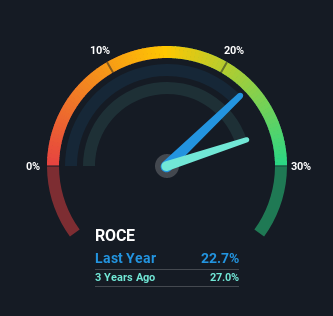Capital Investments At Solar Industries India (NSE:SOLARINDS) Point To A Promising Future

If we want to find a potential multi-bagger, often there are underlying trends that can provide clues. Typically, we'll want to notice a trend of growing return on capital employed (ROCE) and alongside that, an expanding base of capital employed. This shows us that it's a compounding machine, able to continually reinvest its earnings back into the business and generate higher returns. With that in mind, the ROCE of Solar Industries India (NSE:SOLARINDS) looks attractive right now, so lets see what the trend of returns can tell us.
Return On Capital Employed (ROCE): What is it?
For those who don't know, ROCE is a measure of a company's yearly pre-tax profit (its return), relative to the capital employed in the business. To calculate this metric for Solar Industries India, this is the formula:
Return on Capital Employed = Earnings Before Interest and Tax (EBIT) ÷ (Total Assets - Current Liabilities)
0.23 = ₹5.0b ÷ (₹30b - ₹8.2b) (Based on the trailing twelve months to June 2021).
So, Solar Industries India has an ROCE of 23%. That's a fantastic return and not only that, it outpaces the average of 17% earned by companies in a similar industry.
View our latest analysis for Solar Industries India

In the above chart we have measured Solar Industries India's prior ROCE against its prior performance, but the future is arguably more important. If you'd like to see what analysts are forecasting going forward, you should check out our free report for Solar Industries India.
How Are Returns Trending?
In terms of Solar Industries India's history of ROCE, it's quite impressive. The company has employed 107% more capital in the last five years, and the returns on that capital have remained stable at 23%. Now considering ROCE is an attractive 23%, this combination is actually pretty appealing because it means the business can consistently put money to work and generate these high returns. You'll see this when looking at well operated businesses or favorable business models.
What We Can Learn From Solar Industries India's ROCE
In short, we'd argue Solar Industries India has the makings of a multi-bagger since its been able to compound its capital at very profitable rates of return. And long term investors would be thrilled with the 265% return they've received over the last five years. So while investors seem to be recognizing these promising trends, we still believe the stock deserves further research.
If you want to continue researching Solar Industries India, you might be interested to know about the 1 warning sign that our analysis has discovered.
If you'd like to see other companies earning high returns, check out our free list of companies earning high returns with solid balance sheets here.
New: Manage All Your Stock Portfolios in One Place
We've created the ultimate portfolio companion for stock investors, and it's free.
• Connect an unlimited number of Portfolios and see your total in one currency
• Be alerted to new Warning Signs or Risks via email or mobile
• Track the Fair Value of your stocks
This article by Simply Wall St is general in nature. We provide commentary based on historical data and analyst forecasts only using an unbiased methodology and our articles are not intended to be financial advice. It does not constitute a recommendation to buy or sell any stock, and does not take account of your objectives, or your financial situation. We aim to bring you long-term focused analysis driven by fundamental data. Note that our analysis may not factor in the latest price-sensitive company announcements or qualitative material. Simply Wall St has no position in any stocks mentioned.
Have feedback on this article? Concerned about the content? Get in touch with us directly. Alternatively, email editorial-team (at) simplywallst.com.
About NSEI:SOLARINDS
Solar Industries India
Engages in the manufacture and sale of industrial explosives and explosive initiating devices in India and internationally.
Exceptional growth potential with flawless balance sheet.


